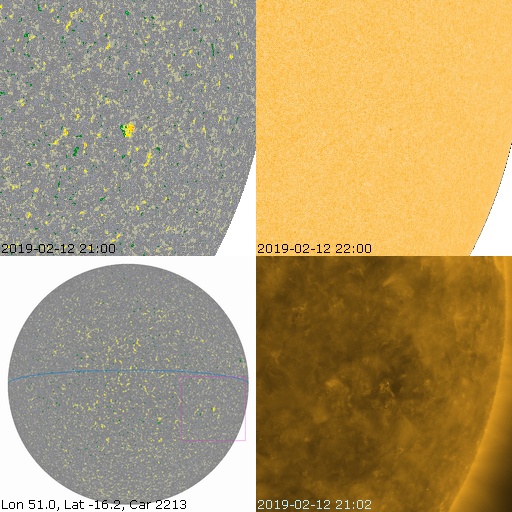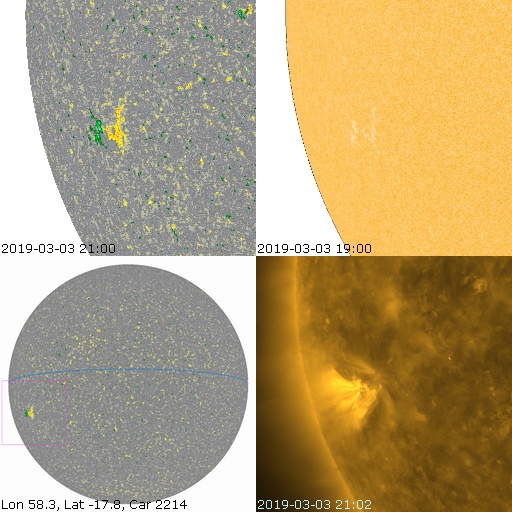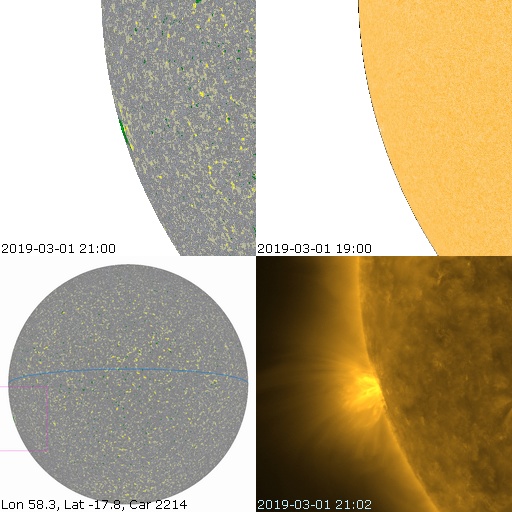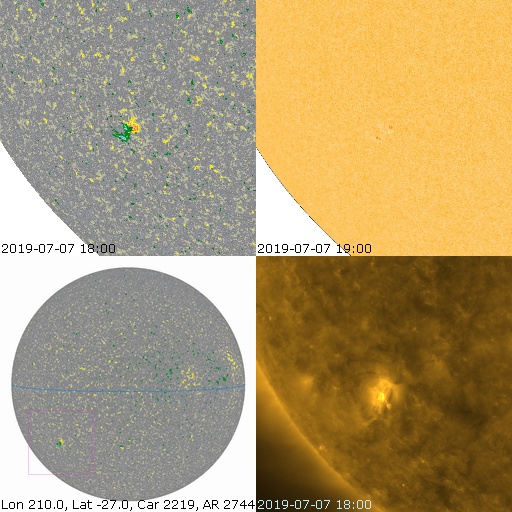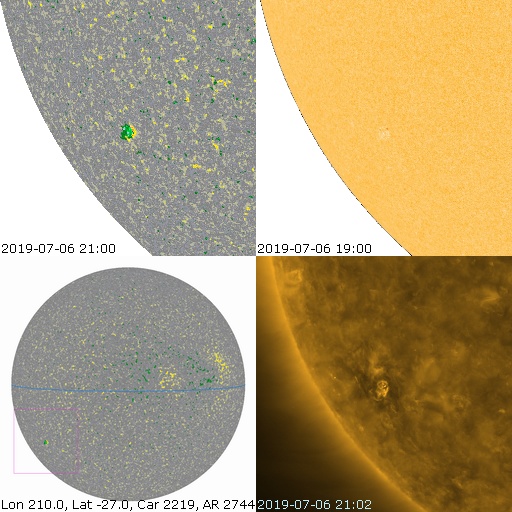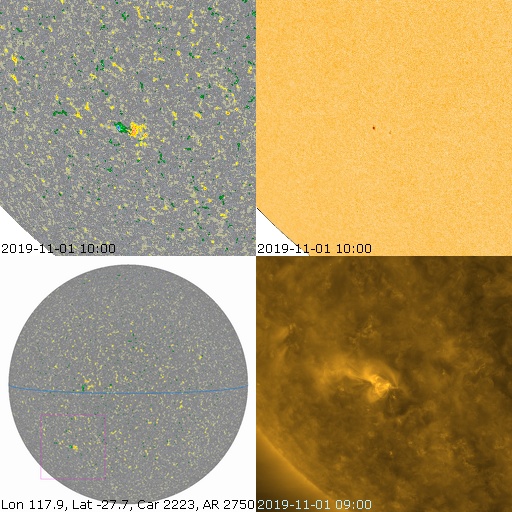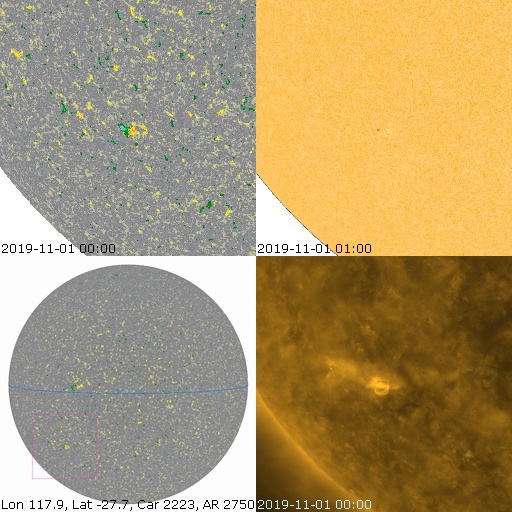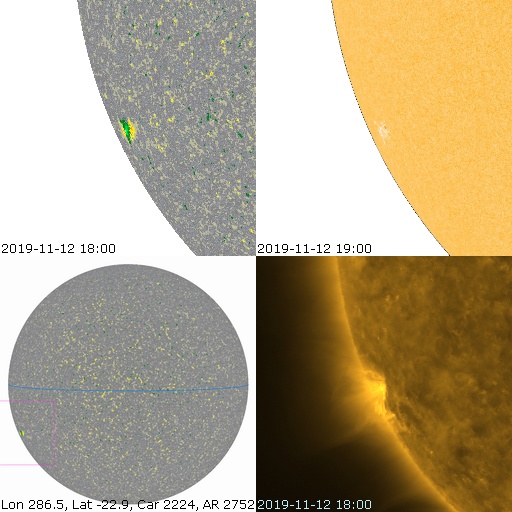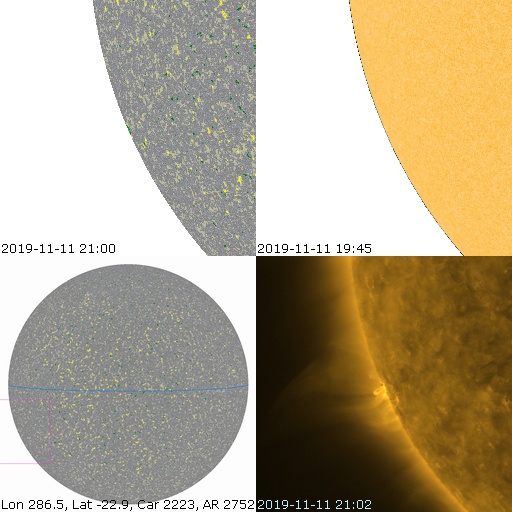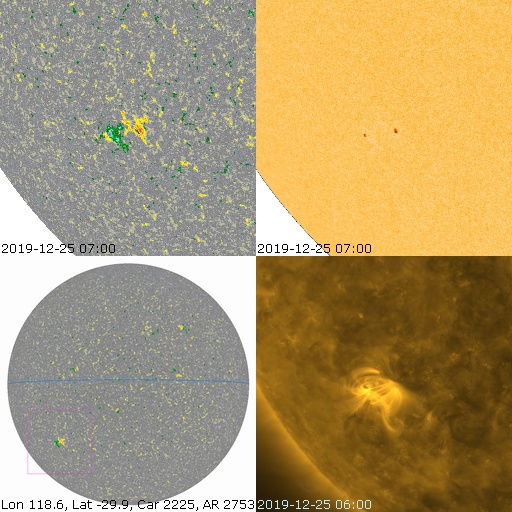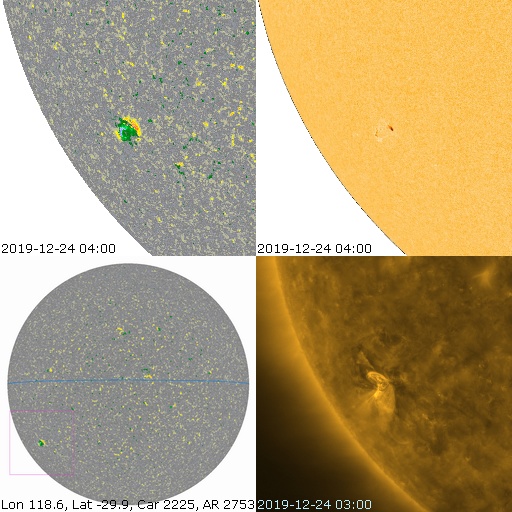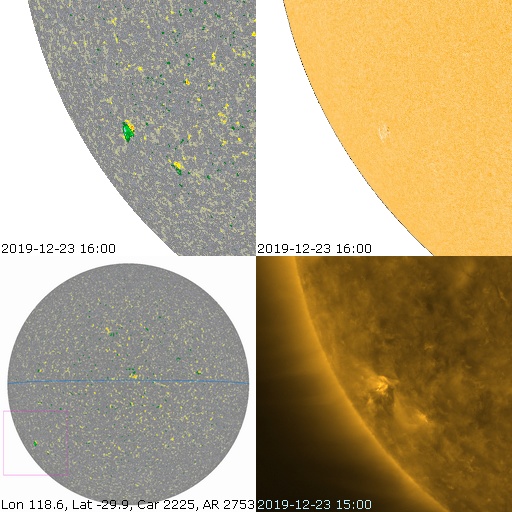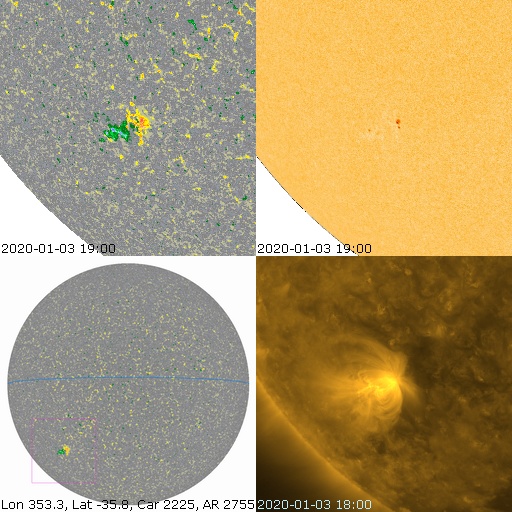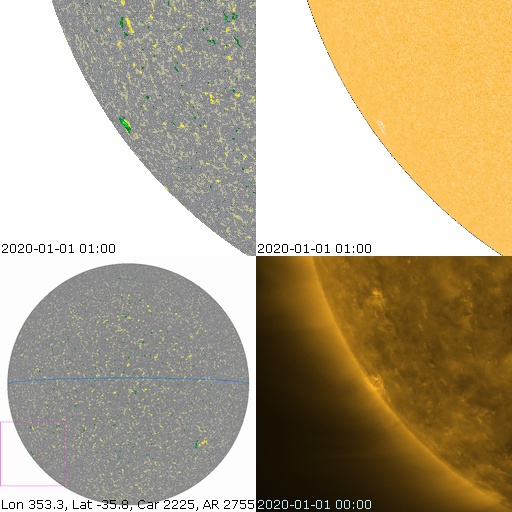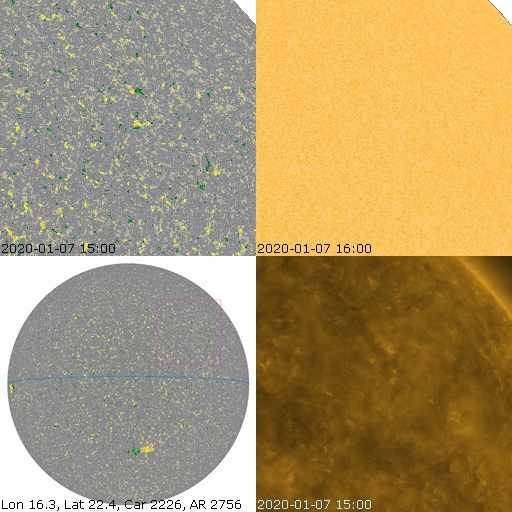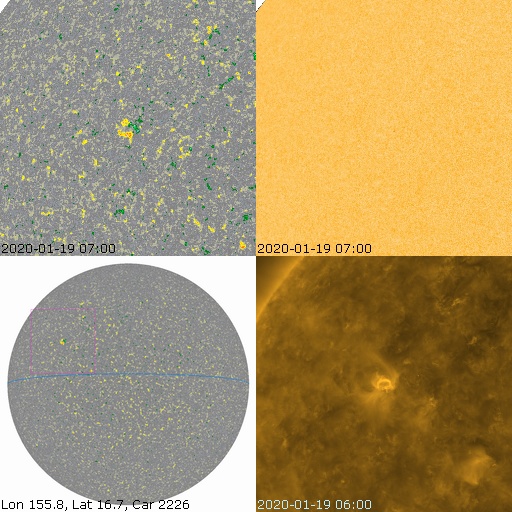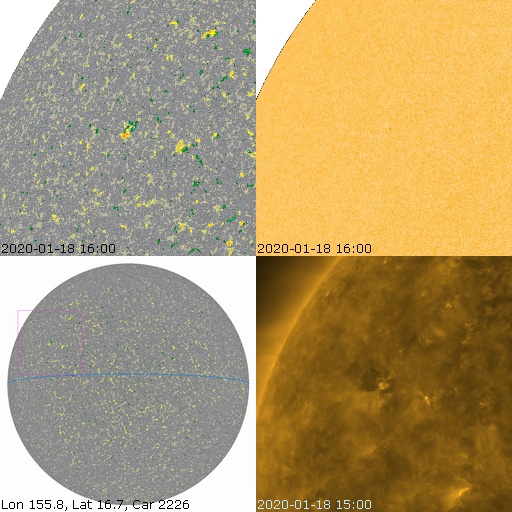Solar Cycle 25 Started on Remarkable Times
(2020-02-02 by P.A.Semi - πα½ )
Abstract:
First sunspots of solar cycle 25 appeared already in year 2019, according to their polarity.
This work lists their dates, with some introduction about sunspot cycle
and magnetic "color" (polarity) of sunspots.
Sunspot Cycle
Solar magnetic activity has a cycle of approximately 11 years.
But since the polar field of the Sun changes around time
of solar maximum,
and direction of sunspots is different in each cycle,
it can be better understood as 22 year cycle
(Hale cycle).
First sunspots of the cycle start appearing at high latitudes,
and then the sunspot belt shifts continually toward the solar equator,
which produces the well-known butterfly diagram,
which is linked to the faster-moving belt
of torsional oscilation.
First sunspots of new cycle often appear, while there are still some sunspots of the old cycle.
Since 1874, sunspot positions were recorded at Greenwich observatory
and then since 1977 continued by USAF by Solar Optical Observing Network.
I determined solar cycle starts
by first appearance of high-latitude sunspots in that dataset,
and since magnetic observations are available,
from SOHO/MDI and SDO/HMI instruments:
| Cycle |
Starting time |
Possibly other starting time |
| SC 12 | 1879-04-15 | |
| SC 13 | 1890-03-04 | |
| SC 14 | 1902-03-06 | |
| SC 15 | 1913-10-08 | 1913-02-22 |
| SC 16 | 1923-09-04 | |
| SC 17 | 1934-02-01 | |
| SC 18 | 1943-05-20 | |
| SC 19 | 1954-10-05 | 1954-07-16 |
| SC 20 | 1963-10-11 | |
| SC 21 | 1975-10-02 | 1975-08-21 |
| SC 22 | 1986-07-07 | 1984-11-21 |
| SC 23 | 1996-05-07 (SOHO/MDI) | 1997-03-29 |
| SC 24 | 2008-09-23 (SOHO/MDI) | |
| SC 25 | 2019-02-12 (SDO/HMI) | |
Table 1 - probable starts of sunspot cycles, as determined by first high-latitude sunspots,
since SC 23 determined by sunspot polarity on magnetograms on SOHO and SDO observatories.
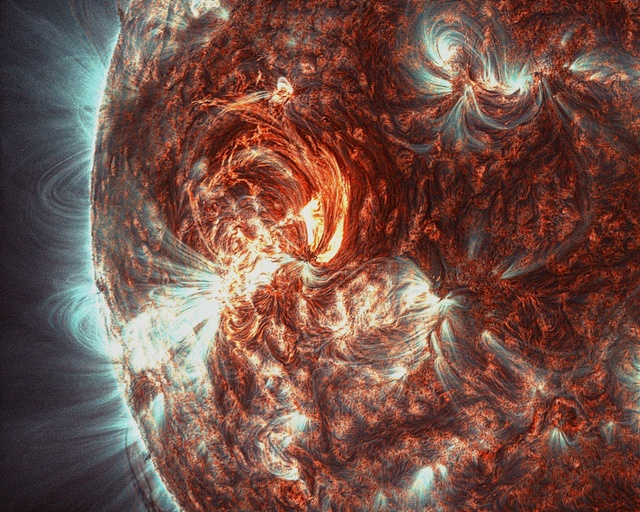
Sunspot in EUV spectrum shifted to visible colors
by modified
PM-NAFE
+DoG algorithm (
video)
Most people (who know about sunspots) think,
that sunspots are dark and color-less,
but actually they are very colorful,
but in different part of light spectrum,
in extreme ultra-violet and X-ray part of spectrum.
Normal solar surface has black-body radiation around 6,000°K,
but magnetic loops above sunspots are almost 1,000,000°K hot.

Color scale used for magnetograms from
JSOC.
Sunspot Polarity
But sunspots also have a "magnetic color",
or rather a polarity of their strong magnetic field.
Sunspots of each new cycle have oppositely oriented
their positive and negative ends,
and sunspots on northern hemisphere are oppositely oriented
than sunspots on southern hemisphere:
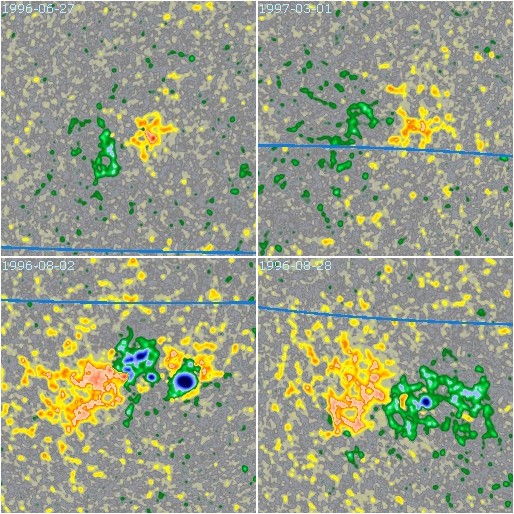
Examples of polarity of sunspots in late
SC 22, northern and southern hemispheres
These magnetograms are filtered with low-frequency filter (FFT-2D)
to remove noise in SOHO/MDI magnetograms,
and same is applied on SDO/HMI magnetograms for visual unification,
and equator is drawn as a blue line.

Examples of polarity of sunspots in
SC 23, northern and southern hemispheres
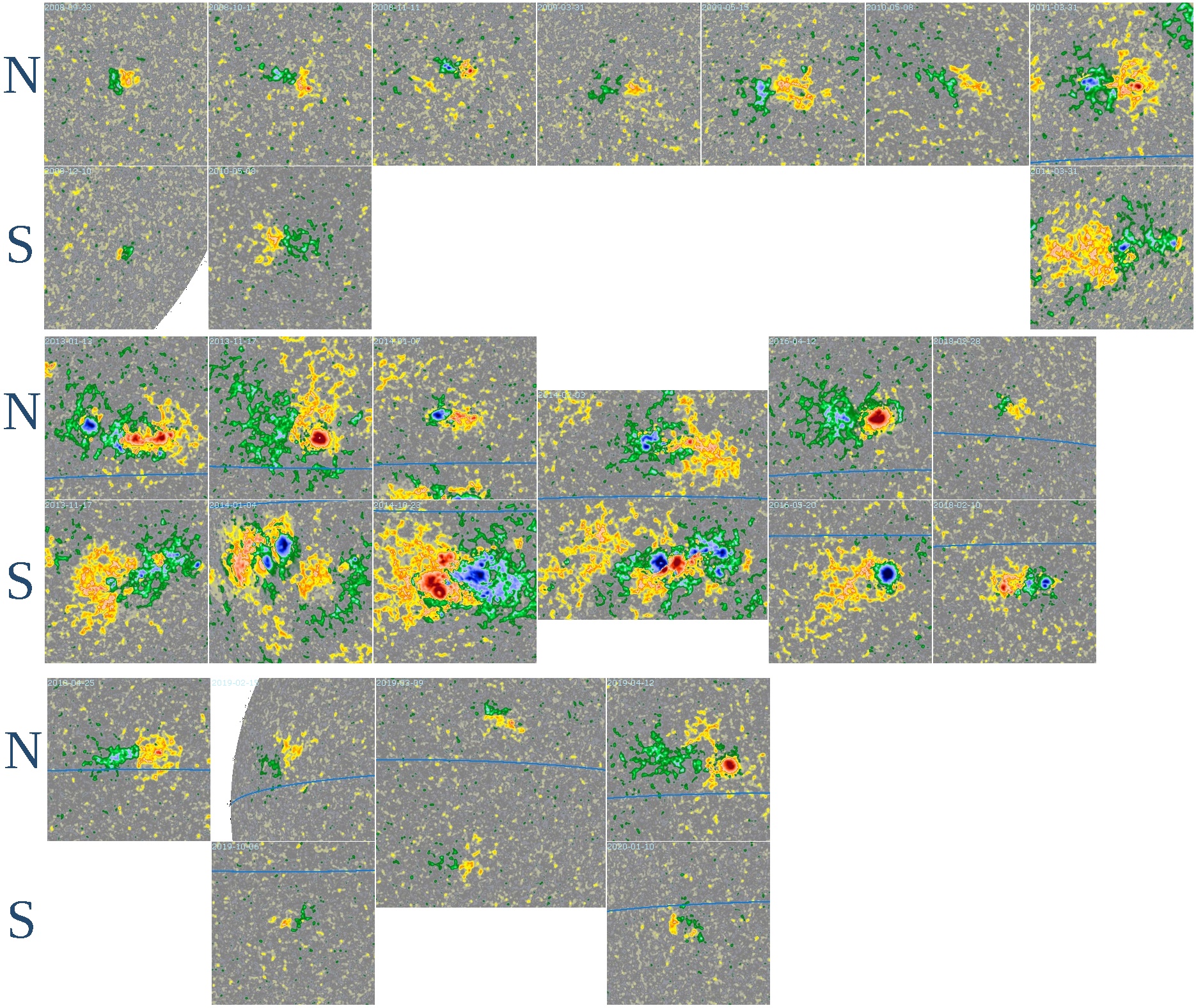
Examples of polarity of sunspots in
SC 24, northern and southern hemispheres
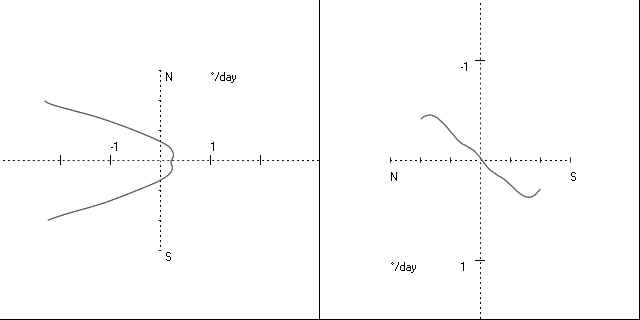
Differential rotation profile in deg/day difference from Carrington rotation, 2010-2018
In SC22 and SC24, northern sunspots have negative field
on leading (right) side (yellow color),
positive field on trailing (left) side (green color),
and southern sunspots are opposite.
In SC23 and SC25, northern sunspots have positive field
on leading (right) side (green color),
negative field on trailing (left) side (yellow color),
and southern sunspots are opposite.
(Animated Magnetic Map of Sun
videos are available for SC 24 and SC 23 in rectangular projection,
front side of Sun is as observed, back side of Sun is interpolated,
flow profile of differential rotation is as measured
by feature-tracking on SDO/HMI magnetograms...)
Notice, that SC24 (2008-2020) has been noticeably weaker
than SC23 (1996-2009).

Magnetic field during solar cycles 23 and 24, one image per year,
selecting some more active time of that year.
(
SC23,
SC24
)
Some Active Regions evolve stronger and there appears a sunspot in visible spectrum, some do not.
Sunspot Cycle 25
Sunspot minimum after SC 24 has been unusually deep, calm and long,
similarly as sunspot minimum between SC 23 and SC 24,
both being deepest minimums in at least a century...
First sunspots or active regions of SC 25 appeared in early 2019 year,
as determined by their polarity, different from SC 24 sunspots,
which also still occur in early 2020...
Probably first sunspot of SC 25 appeared on
Darwin Day,
on 2019-02-12 near western limb.
It's polarity was not well recognizable, since a sunspot viewed on magnetograms
from right side sometimes appears to have an opposite polarity
due to some effect of Doppler measurement of magnetic field.
(Also notable on this day 3 years ago in 2016 Pope Francis and Patriarch Kirill signed
an Ecumenical Declaration
in the first such meeting between leaders of the Catholic and Russian Orthodox Churches
since their split in 1054...)
The same Active Region (without a sunspot)
rolled into view on eastern limb at start of
Roman New Year,
on 2019-03-01 from East side, on same place as moved by a differential rotation,
with obviously the new SC 25 polarity.
(At Roman antiquity times, year started in March,
as is still evidenced by month names September to December being named by latin numerals 7 to 10,
while the first months are named by Roman Emperors - Marcus Aurilius Maius Iunius Julius Augustus?)
Next Sunspot of SC 25 (AR 2744)
appeared on anniversary of Martyrdom of Master
Jan Hus
(Johannes Hus), on 2019-07-06,
which is a national holiday in Czech Republic...
As Jan Hus appealed his condemnation by a rogue council,
which was quarreling for a political might at the time of three popes,
to the Jesus Christ himself, no-one on Earth could arbitrate his case or holiness before,
even when pope Jan Paul II. appologized for his execution at year 2000.
But this time the arbitration in favour of sanctity of Jan Hus came undeniably
from the Sun from God and 24 "old ones"...
Next Sunspot of SC 25 (AR 2750) appeared on
All Saints Day,
on 2019-11-01.
Active region started at late Halloween night,
and Sunspot appeared on early All Saints Day.
Next Active Region rolled into view on eastern limb at Saint Martin
anniversary on 2019-11-11,
evolving into tiny sunspot the day after...
(Earlier on this day 2019-11-11,
between 12:40 UTC and 18:07 UTC occured transit of Mercury in front of Sun
with center at 15:25:14 UTC)
A short sunspot also appeared in this Active Region around midnight
between 2019-11-17 and 2019-11-18 ...
Next Active Region appeared on 2019-12-23 and Sunspot appeared there
on Christmas Day on 2019-12-24.
Next Active Region of SC 25 appeared on late 2012-12-31
and sunspot appeared after midnight 2020-01-01 on New Year Day .
First Active Region of SC 25 on northern hemisphere appeared on
Orthodox Christmas
Day on 2020-01-07, with a sunspot appearing the next day...
Next northern active region with sunspot of SC 25 polarity
appeared on 2020-01-18
and then again on midnight between 2020-01-19 and 2020-01-20 ...
Time of Active Region
appearance on Magnetogram |
Time of Sunspot
on Intensitygram |
Remarks |
| 2019-02-12 16:00 (new) | 2019-02-12 22:00 | Darwin Day |
| 2019-03-01 18:00 (rolling on limb) | | Roman New Year |
| 2019-07-06 12:00 (new) | 2019-07-06 16:00 | martyrdom of Jan Hus (AR 2744) |
| 2019-10-31 06:00 (new) | 2019-11-01 01:00 | All Saints Day (AR 2750) |
| 2019-11-11 21:00 (rolling on limb) | 2019-11-12 13:00 | Saint Martin (AR 2752) |
| 2019-12-23 06:00 (new) | 2019-12-23 16:00 | Christmas Day (almost) (AR 2753) |
| 2019-12-31 23:00 (new) | 2020-01-01 04:00 | New Year Day (AR 2755) |
| 2020-01-07 12:00 (new, northern) | 2020-01-08 13:00 | Orthodox Christmas Day (AR 2756) |
| 2020-01-18 06:00 (new, northern) | 2020-01-18 13:00 | 2020-01-19 19:00 |
Table2 - Times of first Active Regions and Sunspots in SC 25.
Other numbered Active Regions belonged to the SC 24 according to their polarity...
(Magnetogram times are with 1-hour granularity,
Intensitygram times are with 3-hour granularity...)
Conclusion
While on former years, sunspots seemed to appear in relation with planetary positions
(Apparent Relations between Solar Activity and Solar Tides, Ching-Cheh Hung 2007),
or at random,
this time their correspondence with times of Christian holidays
and starts of Calendary does not appear random at all and is hardly deniable...
Video
is available with the Sunpots...
(SDO/HMI Magnetogram, cropped and full-disk, SDO/HMIIF Intensitygram, SDO/AIA 171A EUV)
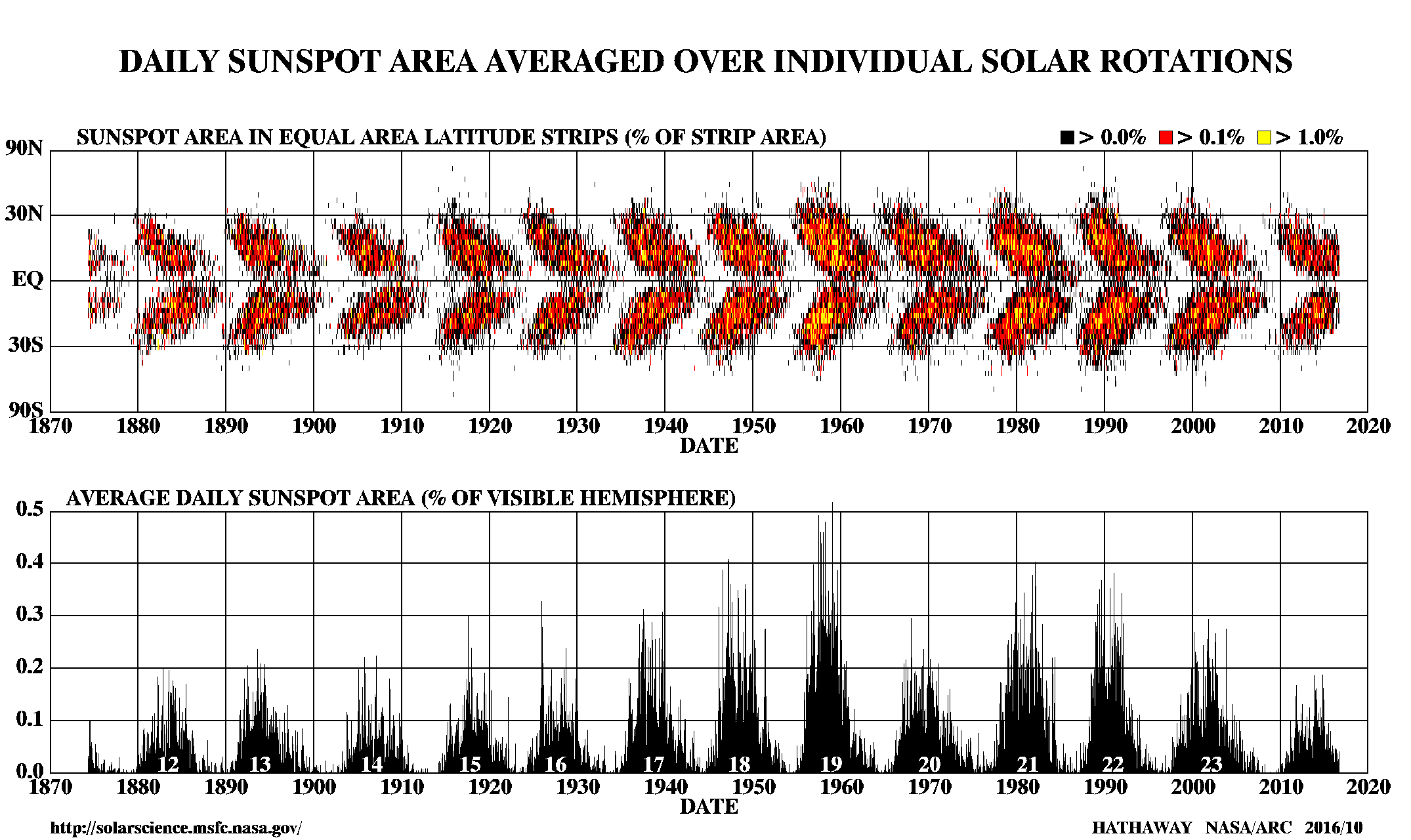
 Color scale used for magnetograms from
JSOC.
Color scale used for magnetograms from
JSOC.
 Examples of polarity of sunspots in late SC 22, northern and southern hemispheres
Examples of polarity of sunspots in late SC 22, northern and southern hemispheres
 Examples of polarity of sunspots in SC 23, northern and southern hemispheres
Examples of polarity of sunspots in SC 23, northern and southern hemispheres
 Examples of polarity of sunspots in SC 24, northern and southern hemispheres
Examples of polarity of sunspots in SC 24, northern and southern hemispheres


